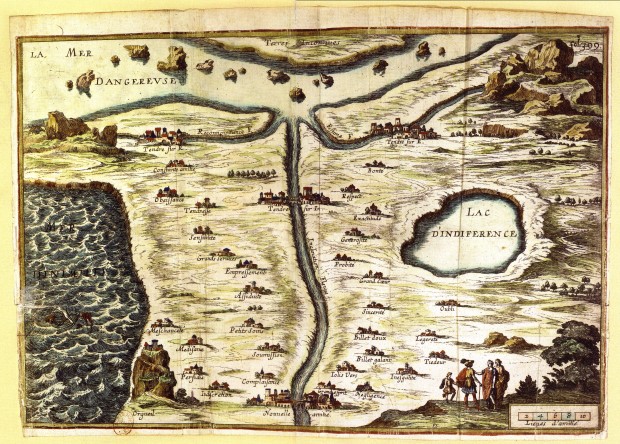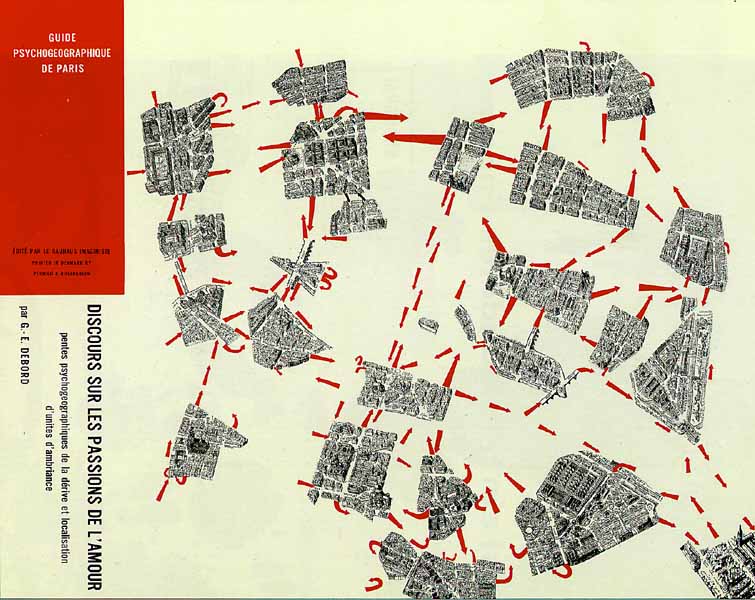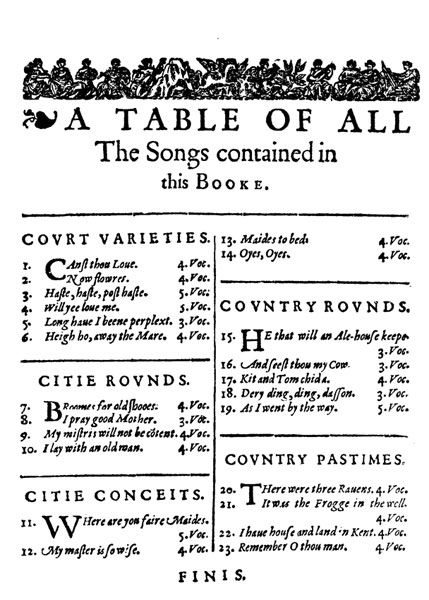A Poetics of the Dérive and Other Cartographies…
The Map of Tendre (Carte de Tendre or Carte du Tendre) was a French map of an imaginary land called Tendre produced by several different people. It appeared as an engraving (attributed to François Chauveau) in the first part of Madeleine de Scudéry’s 1654-61 novel Clélie.
“Allegorical map of the stages of love; one can go by way of the Reconaissance river (through the towns of Constante Amitié, Obeissance, Tendresse, Sensibilité, Grandes Services, Empressements, Assiduité, Petits Soins, Soumission, Complaisance) or by way of the Estime river (through the towns of Bonté, Respect, Exactitude, Generosité, Probité, Grand Coeur, Sincerité, Billet doux, Billet galant, Jolis Vers, and Grand esprit), or by way of the Inclination river (the most direct route) to arrive at the goal of Nouvelle Amitié. However, avoid Meschanceté, Médisance, Perfidie, Indiscretion, and Orgueil near the Mer d’Inimitié, as well as Oubli, Legereté, Tiedeur, Inegalité, and Negligence on the side of the Lac D’Indiference.”
Exercise: Write / draw your own topographical map of a current state of mind, body, emotions that might or might not be your own.
Consider the usefulness of imaginary maps and mapping for your own poetic practice. How might poems offer ‘impossible’ maps of physical and / or abstract states?
from ‘THE PETTICHAP’S NEST’ John Clare
WELL! in my many walks I’ve rarely found
A place less likely for a bird to form
Its nest—close by the rut-gulled waggon-road,
And on the almost bare foot-trodden ground,
With scarce a clump of grass to keep it warm!
Where not a thistle spreads its spears abroad,
Or prickly bush, to shield it from harm’s way;
And yet so snugly made, that none may spy
It out, save peradventure. You and I
Had surely passed it in our walk to-day,
Had chance not led us by it!—Nay, e’en now,
Had not the old bird heard us trampling bye,
And fluttered out, we had not seen it lie,
Brown as the road-way side.
[…]
I’ve often found her nest in chance’s way,
When I in pathless woods did idly roam;
But never did I dream until to-day
A spot like this would be her chosen home.
Read the whole poem here.
In Clare’s poem he is not looking for the birds nest he happens upon it ‘peradventure’.
How can your own poems be informed by similar activity or sense of chance and happenstance?
For Clare it is important that he is engaged in the act of ‘walking’ in the ‘pathless woods’. They are pathless because the routes through them are not known. Clare is off route in terms of the expectations of how he should physically move through the space of the wood. He is not looking for the nest — but comes to be central to the poem. He finds it through the activity of traversing the ‘pathless woods’.
(Byron also mentions ‘pathless woods’ in ‘Childe Harold‘).
How can your own experience of writing and of making poems involve itself in the movement through pathless woods?
Do you recognise any relationships / similarities or differences between the Map of Tendre’ and the poem by Clare?
John Ashbery, ‘For John Clare’
From ‘For John Clare‘ by John Ashbery.
[…]
Read full poem here and listen to Ashbery reading
and also ‘October at the Window’  MP3
MP3
You can also listen to Ashbery’s Harvard lecture on Clare on Penn Sound
Consider the ways in which Ashbery’s poem presents a call for new cartographies of mapping and spatialisation — both of syntax, landscape and objects / in space.
What possibilities does it offer in the representation of a poetics of alternative cartographic mapping as compared to the Map of Tendre or the poem by Clare?
How can we use these insights to inform our own writing practice?
Exercise: Experiment with writing alternative cartographies of the spaces that you are currently occupying. How can you rewrite the existing and apparently incontrovertible terrain in relation to the intangible and the ephemeral?
Situationism and the Dérive
Guy Debord, 1955 (?) “Psychogeographic guide of Paris”: edited by the Bauhaus Imaginiste Printed in Denmark by Permild & Rosengreen – Discourse on the passions of love: psychogeographic descents of drifting and localisation of ambient unities”
Some of these ideas and possibilities might be taken out of context and re-discovered alongside some of the Situationist writings and their formulation of the term Dérive.
Read the entire essays or consider some of the following extracts:
from Guy Debord Introduction to a Critique of Urban Geography Published in Les Lèvres Nues #6 1955
“Psychogeographical Game of the Week” published, not without a certain humor, in Potlatch #1:
“In accordance with what you are seeking, choose a country, a more or less populated city, a more or less busy street. Build a house. Furnish it. Use decorations and surroundings to the best advantage. Choose the season and the time of day. Bring together the most suitable people, with appropriate records and drinks. The lighting and the conversation should obviously be suited to the occasion, as should be the weather or your memories.
“If there has been no error in your calculations, the result should satisfy you.”
[ . . . ]
People are quite aware that some neighborhoods are sad and others pleasant. But they generally simply assume elegant streets cause a feeling of satisfaction and that poor street are depressing, and let it go at that. In fact, the variety of possible combinations of ambiances, analogous to the blending of pure chemicals in an infinite number of mixtures, gives rise to feelings as differentiated and complex as any other form of spectacle can evoke. The slightest demystified investigation reveals that the qualitatively or quantitatively different influences of diverse urban decors cannot be determined solely on the basis of the era or architectural style, much less on the basis of housing conditions.
[ . . .]
Among various more difficult means of intervention, a renovated cartography seems appropriate for immediate utilization.
The production of psychogeographic maps, or even the introduction of alterations such as more or less arbitrarily transposing maps of two different regions, can contribute to clarifying certain wanderings that express not subordination to randomness but complete insubordination to habitual influences (influences generally categorized as tourism that popular drug as repugnant as sports or buying on credit). A friend recently told me that he had just wandered through the Harz region of Germany while blindly following the directions of a map of London This sort of game is obviously only a mediocre beginning in comparison to the complete construction of architecture and urbanism that will someday be within the power of everyone.
from Guy Debord Theory of Dérive Les Lèvres Nues #9 (November 1956)
(reprinted in Internationale Situationniste #2 (December 1958))
ONE OF THE BASIC situationist practices is the dérive [literally: “drifting”], a technique of rapid passage through varied ambiances. Dérives involve playful-constructive behavior and awareness of psychogeographical effects, and are thus quite different from the classic notions of journey or stroll.
In a dérive one or more persons during a certain period drop their relations, their work and leisure activities, and all their other usual motives for movement and action, and let themselves be drawn by the attractions of the terrain and the encounters they find there. Chance is a less important factor in this activity than one might think: from a dérive point of view cities have psychogeographical contours, with constant currents, fixed points and vortexes that strongly discourage entry into or exit from certain zones.
But the dérive includes both this letting-go and its necessary contradiction: the domination of psychogeographical variations by the knowledge and calculation of their possibilities. In this latter regard, ecological science — despite the narrow social space to which it limits itself — provides psychogeography with abundant data.
The ecological analysis of the absolute or relative character of fissures in the urban network, of the role of microclimates, of distinct neighborhoods with no relation to administrative boundaries, and above all of the dominating action of centers of attraction, must be utilized and completed by psychogeographical methods. The objective passional terrain of the dérive must be defined in accordance both with its own logic and with its relations with social morphology.
Exercise:
Write down a list of alternative logics for making a route (e.g. leaves on ground, direction of wind, colour of hats, direction in which bicycles parked, cracks on ground, chance, random…).
Write down a list of possible reasons to stop and write (e.g. at the corners of buildings, when a person crosses your path, when you see something blue…)
Give yourself a set amount of time. Go for a walk and do some writing and see what happens…!
(You might need to adapt your ‘rules’ and ‘prompts’ to see what generates the most useful forms of writing practice? Experiment with different locations, different times of day, singly and in groups? How can you refine your procedures towards a politically engaged practice — or towards the themes and ideas that are necessary for you to engage with in relation to your environment?)
Once you have produced some phrases you might like to annotate your own map http://map.cam.ac.uk/ or perhaps make a new map new directions and finds for a dérive…
Susan Philipsz: SURROUND ME
And finally, not so much as a derive as an installed re-imagining of this city in relation to the sound of Elizabethan songs which are played in a series of spaces around the city at the weekend.![]()
Selected pages from a songbook by Thomas Ravenscroft
A Song Cycle for the City of London
(Saturdays & Sundays, 9 October 2010 – 2 January 2011)
Through the superimposition of Elizabethan songs onto streets and areas of London, Philipsz sonic piece presents her listeners with her own re-mapping. The use of the relationships between the material of the modern buildings, the names of the streets and the choice of the images in the songs is especially well considered — as in the network of correspondences that she builds between crying, glass and water.
See also: Steven Connor’s review of ‘Surround Me’ and map
Further Writing:
Consider making and writing your own cartographies in poems and map form…
How can you work with researched materials in relation to particular sites?
You might want to try these Apps (click for link) which encourage derives through randomly generated instruction cards….or you could just make your own analogue version….
You know out of real cards!
I am looking forward to seeing what kinds of work you develop out of the session…
Happy Writing!


